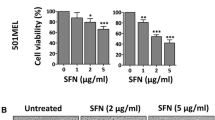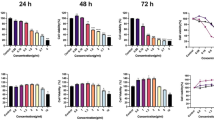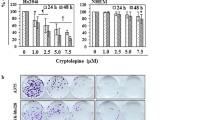Abstract
Purpose
l-Theanine is a unique non-protein amino acid found in green tea, which has been identified as a safe dietary supplement. It has been reported that l-theanine exerts various biological activities. In this study, we explored the anti-cancer effects of l-theanine on melanoma cells.
Methods
A375, B16–F10, and PIG1 cell lines were used in the present study. EdU labeling, TUNEL and Annexin V/PI staining, wound-healing, and transwell migration assay were performed to detect the effects of l-theanine on melanoma cell proliferation, apoptosis, and migration. Brain and muscle Arnt-like protein 1 (BMAL1) was knocked down in melanoma cells to evaluate if l-theanine plays the anti-cancer role through regulating circadian rhythm of melanoma cells. The western blot, qRT-PCR, and dual luciferase assay were performed to explore the mechanism involved in the effects of l-theanine on melanoma cells.
Results
l-Theanine apparently reduced the viability of melanoma cells. Further experiments showed that l-theanine attenuated the proliferation and migration, and promoted apoptosis of melanoma cells. l-Theanine significantly enhanced the expression of BMAL1, a clock gene in melanoma cells. Down-regulation of BMAL1 suppressed the anti-cancer effects of l-theanine on melanoma cells. Further experiments indicated that the p53 transcriptional activity raised by l-theanine was dependent on BMAL1 expression in melanoma cells.
Conclusion
l-Theanine exerts the anti-cancer effect on melanoma cells through attenuating the proliferation and migration, and promoting apoptosis of them, which is dependent on the regulation of the clock gene Bmal1 in melanoma cells.








Similar content being viewed by others
Abbreviations
- BMAL1:
-
Brain and muscle Arnt-like protein
- CLOCK:
-
Circadian locomotor output cycles kaput
- CRY1:
-
Cryptochrome 1
- EdU:
-
5-Ethynyl-2′-deoxyuridine
- ICAM-1:
-
Intracellular adhesion molecule-1
- MMP:
-
Matrix metalloproteinase
- PCNA:
-
Proliferating cell nuclear antigen
- PER1:
-
Period 1
- PER2:
-
Period 2
- TUNEL:
-
Terminal deoxynucleotidyl transferase dUTP nick-end labeling
- VCAM-1:
-
Vascular cell adhesion molecule-1
References
Abbas O, Miller DD, Bhawan J (2014) Cutaneous malignant melanoma: update on diagnostic and prognostic biomarkers. Am J Dermatopathol 36(5):363–379. https://doi.org/10.1097/DAD.0b013e31828a2ec5
O’Neill CH, Scoggins CR (2019) Melanoma. J Surg Oncol 120(5):873–881. https://doi.org/10.1002/jso.25604
Klicks J, Masslo C, Kluth A, Rudolf R, Hafner M (2019) A novel spheroid-based co-culture model mimics loss of keratinocyte differentiation, melanoma cell invasion, and drug-induced selection of ABCB5-expressing cells. BMC Cancer 19(1):402. https://doi.org/10.1186/s12885-019-5606-4
Song F, Amos CI, Lee JE, Lian CG, Fang S, Liu H, MacGregor S, Iles MM, Law MH, Lindeman NI, Montgomery GW, Duffy DL, Cust AE, Jenkins MA, Whiteman DC, Kefford RF, Giles GG, Armstrong BK, Aitken JF, Hopper JL, Brown KM, Martin NG, Mann GJ, Bishop DT, Bishop JA, Geno MELC, Kraft P, Qureshi AA, Kanetsky PA, Hayward NK, Hunter DJ, Wei Q, Han J (2014) Identification of a melanoma susceptibility locus and somatic mutation in TET2. Carcinogenesis 35(9):2097–2101. https://doi.org/10.1093/carcin/bgu140
Wilson MA, Schuchter LM (2016) Chemotherapy for melanoma. Cancer Treat Res 167:209–229. https://doi.org/10.1007/978-3-319-22539-5_8
Livingstone E, Zimmer L, Vaubel J, Schadendorf D (2014) BRAF, MEK and KIT inhibitors for melanoma: adverse events and their management. Chin Clin Oncol 3(3):29. https://doi.org/10.3978/j.issn.2304-3865.2014.03.03
Peters BA, Wilson M, Moran U, Pavlick A, Izsak A, Wechter T, Weber JS, Osman I, Ahn J (2019) Relating the gut metagenome and metatranscriptome to immunotherapy responses in melanoma patients. Genome Med 11(1):61. https://doi.org/10.1186/s13073-019-0672-4
Lengyel Z, Lovig C, Kommedal S, Keszthelyi R, Szekeres G, Battyani Z, Csernus V, Nagy AD (2013) Altered expression patterns of clock gene mRNAs and clock proteins in human skin tumors. Tumour Biol 34(2):811–819. https://doi.org/10.1007/s13277-012-0611-0
Roenneberg T, Merrow M (2016) The circadian clock and human health. Curr Biol 26(10):R432–R443. https://doi.org/10.1016/j.cub.2016.04.011
Zhao M, Zhao H, Deng J, Guo L, Wu B (2019) Role of the CLOCK protein in liver detoxification. Br J Pharmacol 176(24):4639–4652. https://doi.org/10.1111/bph.14828
de Assis LVM, Kinker GS, Moraes MN, Markus RP, Fernandes PA, Castrucci AML (2018) Expression of the circadian clock gene BMAL1 positively correlates with antitumor immunity and patient survival in metastatic melanoma. Front Oncol 8:185. https://doi.org/10.3389/fonc.2018.00185
Duguay D, Cermakian N (2009) The crosstalk between physiology and circadian clock proteins. Chronobiol Int 26(8):1479–1513. https://doi.org/10.3109/07420520903497575
Kiessling S, Beaulieu-Laroche L, Blum ID, Landgraf D, Welsh DK, Storch KF, Labrecque N, Cermakian N (2017) Enhancing circadian clock function in cancer cells inhibits tumor growth. BMC Biol 15(1):13. https://doi.org/10.1186/s12915-017-0349-7
de Assis LVM, Moraes MN, Castrucci AML (2019) The molecular clock in the skin, its functionality, and how it is disrupted in cutaneous melanoma: a new pharmacological target? Cell Mol Life Sci 76(19):3801–3826. https://doi.org/10.1007/s00018-019-03183-5
Li W, Xiang F, Zhong M, Zhou L, Liu H, Li S, Wang X (2017) Transcriptome and metabolite analysis identifies nitrogen utilization genes in tea plant (Camellia sinensis). Sci Rep 7(1):1693. https://doi.org/10.1038/s41598-017-01949-0
Ogawa S, Ota M, Ogura J, Kato K, Kunugi H (2018) Effects of l-theanine on anxiety-like behavior, cerebrospinal fluid amino acid profile, and hippocampal activity in Wistar Kyoto rats. Psychopharmacology 235(1):37–45. https://doi.org/10.1007/s00213-017-4743-1
Hwang YP, Jin SW, Choi JH, Choi CY, Kim HG, Kim SJ, Kim Y, Lee KJ, Chung YC, Jeong HG (2017) Inhibitory effects of l-theanine on airway inflammation in ovalbumin-induced allergic asthma. Food Chem Toxicol 99:162–169. https://doi.org/10.1016/j.fct.2016.11.032
Bi A, Hang Q, Huang Y, Zheng S, Bi X, Zhang Z, Yin Z, Luo L (2020) l-Theanine attenuates neointimal hyperplasia via suppression of vascular smooth muscle cell phenotypic modulation. J Nutr Biochem 82:108398. https://doi.org/10.1016/j.jnutbio.2020.108398
Xin Y, Ben P, Wang Q, Zhu Y, Yin Z, Luo L (2018) Theanine, an antitumor promoter, induces apoptosis of tumor cells via the mitochondrial pathway. Mol Med Rep 18(5):4535–4542. https://doi.org/10.3892/mmr.2018.9459
Sugiyama T, Sadzuka Y (2004) Theanine, a specific glutamate derivative in green tea, reduces the adverse reactions of doxorubicin by changing the glutathione level. Cancer Lett 212(2):177–184. https://doi.org/10.1016/j.canlet.2004.03.040
Liu Q, Duan H, Luan J, Yagasaki K, Zhang G (2009) Effects of theanine on growth of human lung cancer and leukemia cells as well as migration and invasion of human lung cancer cells. Cytotechnology 59(3):211–217. https://doi.org/10.1007/s10616-009-9223-y
Liu J, Sun Y, Zhang H, Ji D, Wu F, Tian H, Liu K, Zhang Y, Wu B, Zhang G (2016) Theanine from tea and its semi-synthetic derivative TBrC suppress human cervical cancer growth and migration by inhibiting EGFR/Met-Akt/NF-kappaB signaling. Eur J Pharmacol 791:297–307. https://doi.org/10.1016/j.ejphar.2016.09.007
Sharma E, Joshi R, Gulati A (2018) l-Theanine: an astounding sui generis integrant in tea. Food Chem 242:601–610. https://doi.org/10.1016/j.foodchem.2017.09.046
Vuong QV, Bowyer MC, Roach PD (2011) l-Theanine: properties, synthesis and isolation from tea. J Sci Food Agric 91(11):1931–1939. https://doi.org/10.1002/jsfa.4373
Saeed M, Naveed M, Arif M, Kakar MU, Manzoor R, Abd El-Hack ME, Alagawany M, Tiwari R, Khandia R, Munjal A, Karthik K, Dhama K, Iqbal HMN, Dadar M, Sun C (2017) Green tea (Camellia sinensis) and l-theanine: medicinal values and beneficial applications in humans—a comprehensive review. Biomed Pharmacother 95:1260–1275. https://doi.org/10.1016/j.biopha.2017.09.024
Wise LE, Premaratne ID, Gamage TF, Lichtman AH, Hughes LD, Harris LS, Aceto MD (2012) l-Theanine attenuates abstinence signs in morphine-dependent rhesus monkeys and elicits anxiolytic-like activity in mice. Pharmacol Biochem Behav 103(2):245–252. https://doi.org/10.1016/j.pbb.2012.08.008
Rao TP, Ozeki M, Juneja LR (2015) In search of a safe natural sleep aid. J Am Coll Nutr 34(5):436–447. https://doi.org/10.1080/07315724.2014.926153
Wang R, Xiao M, Zhang Y, Ho CT, Wan X, Li D, Xie Z (2019) RNA-sequencing analysis reveals l-theanine regulating transcriptional rhythm alteration in vascular smooth muscle cells induced by dexamethasone. J Agric Food Chem 67(19):5413–5422. https://doi.org/10.1021/acs.jafc.8b05057
Luangpraditkun K, Charoensit P, Grandmottet F, Viennet C, Viyoch J (2020) Photoprotective potential of the natural artocarpin against in vitro UVB-induced apoptosis. Oxid Med Cell Longev 2020:1042451. https://doi.org/10.1155/2020/1042451
Rodriguez LG, Wu X, Guan J-L (2005) Wound-healing assay. Methods Mol Biol 294:23–29. https://doi.org/10.1385/1-59259-860-9:023
Marshall J (2011) Transwell invasion assays. Methods Mol Biol 769:97–110. https://doi.org/10.1007/978-1-61779-207-6_8
Kyrylkova K, Kyryachenko S, Leid M, Kioussi C (2012) Detection of apoptosis by TUNEL assay. Methods Mol Biol 887:41–47. https://doi.org/10.1007/978-1-61779-860-3_5
Jiang W, Zhao S, Jiang X, Zhang E, Hu G, Hu B, Zheng P, Xiao J, Lu Z, Lu Y, Ni J, Chen C, Wang X, Yang L, Wan R (2016) The circadian clock gene Bmal1 acts as a potential anti-oncogene in pancreatic cancer by activating the p53 tumor suppressor pathway. Cancer Lett 371(2):314–325. https://doi.org/10.1016/j.canlet.2015.12.002
Woo SM, Seo SU, Kubatka P, Min KJ, Kwon TK (2019) Honokiol enhances TRAIL-mediated apoptosis through STAMBPL1-induced survivin and c-FLIP degradation. Biomolecules. https://doi.org/10.3390/biom9120838
Li C, Yan Q, Tang S, Xiao W, Tan Z (2018) l-Theanine protects H9C2 cells from hydrogen peroxide-induced apoptosis by enhancing antioxidant capability. Med Sci Monit 24:2109–2118. https://doi.org/10.12659/msm.907660
Sun Y, Niu X, Wang G, Qiao X, Chen L, Zhong M (2020) A novel lncRNA ENST00000512916 facilitates cell proliferation, migration and cell cycle progression in ameloblastoma. Onco Targets Ther 13:1519–1531. https://doi.org/10.2147/OTT.S236158
Wang Y, Guo SH, Shang XJ, Yu LS, Zhu JW, Zhao A, Zhou YF, An GH, Zhang Q, Ma B (2018) Triptolide induces Sertoli cell apoptosis in mice via ROS/JNK-dependent activation of the mitochondrial pathway and inhibition of Nrf2-mediated antioxidant response. Acta Pharmacol Sin 39(2):311–327. https://doi.org/10.1038/aps.2017.95
Huang CY, Lin CY, Tsai CW, Yin MC (2011) Inhibition of cell proliferation, invasion and migration by ursolic acid in human lung cancer cell lines. Toxicol In Vitro 25(7):1274–1280. https://doi.org/10.1016/j.tiv.2011.04.014
Shafi AA, Knudsen KE (2019) Cancer and the circadian clock. Cancer Res 79(15):3806–3814. https://doi.org/10.1158/0008-5472.CAN-19-0566
Kawamura G, Hattori M, Takamatsu K, Tsukada T, Ninomiya Y, Benjamin I, Sassone-Corsi P, Ozawa T, Tamaru T (2018) Cooperative interaction among BMAL1, HSF1, and p53 protects mammalian cells from UV stress. Commun Biol 1:204. https://doi.org/10.1038/s42003-018-0209-1
Rastrelli M, Tropea S, Rossi CR, Alaibac M (2014) Melanoma: epidemiology, risk factors, pathogenesis, diagnosis and classification. In Vivo 28(6):1005–1011
Wang SC (2014) PCNA: a silent housekeeper or a potential therapeutic target? Trends Pharmacol Sci 35(4):178–186. https://doi.org/10.1016/j.tips.2014.02.004
Zheng N, Chen J, Liu W, Wang J, Liu J, Jia L (2017) Metapristone (RU486 derivative) inhibits cell proliferation and migration as melanoma metastatic chemopreventive agent. Biomed Pharmacother 90:339–349. https://doi.org/10.1016/j.biopha.2017.03.076
Xu W, McArthur G (2016) Cell cycle regulation and melanoma. Curr Oncol Rep 18(6):34. https://doi.org/10.1007/s11912-016-0524-y
Hanahan D, Weinberg RA (2011) Hallmarks of cancer: the next generation. Cell 144(5):646–674. https://doi.org/10.1016/j.cell.2011.02.013
Lu L, Zhang J, Gan P, Wu L, Zhang X, Peng C, Zhou J, Chen X, Su J (2021) Novel functions of CD147 in the mitochondria exacerbates melanoma metastasis. Int J Biol Sci 17(1):285–297. https://doi.org/10.7150/ijbs.52043
Galore-Haskel G, Baruch EN, Berg AL, Barshack I, Zilinsky I, Avivi C, Besser MJ, Schachter J, Markel G (2017) Histopathological expression analysis of intercellular adhesion molecule 1 (ICAM-1) along development and progression of human melanoma. Oncotarget 8(59):99580–99586. https://doi.org/10.18632/oncotarget.20884
Ghislin S, Obino D, Middendorp S, Boggetto N, Alcaide-Loridan C, Deshayes F (2012) LFA-1 and ICAM-1 expression induced during melanoma-endothelial cell co-culture favors the transendothelial migration of melanoma cell lines in vitro. BMC Cancer 12:455. https://doi.org/10.1186/1471-2407-12-455
Kondratiev S, Gnepp DR, Yakirevich E, Sabo E, Annino DJ, Rebeiz E, Laver NV (2008) Expression and prognostic role of MMP2, MMP9, MMP13, and MMP14 matrix metalloproteinases in sinonasal and oral malignant melanomas. Hum Pathol 39(3):337–343. https://doi.org/10.1016/j.humpath.2007.07.003
Fu L, Lee CC (2003) The circadian clock: pacemaker and tumour suppressor. Nat Rev Cancer 3(5):350–361. https://doi.org/10.1038/nrc1072
Aiello I, Fedele MLM, Roman F, Marpegan L, Caldart C, Chiesa JJ, Golombek DA, Finkielstein CV, Paladino N (2020) Circadian disruption promotes tumor-immune microenvironment remodeling favoring tumor cell proliferation. Sci Adv. https://doi.org/10.1126/sciadv.aaz4530
Acknowledgements
This work was funded by the National Natural Science Foundation of China [Nos. 81711703].
Funding
This work was supported by the National Natural Science Foundation of China [Nos. 81711703].
Author information
Authors and Affiliations
Contributions
RZ, ZY, and LL conceived and designed the research. RZ, SZ, ZG, YW, and GY performed the experiment and acquired the data. RZ and SZ performed statistical analysis. RZ and LL drafted the manuscript. LL handled funding and supervision.
Corresponding authors
Ethics declarations
Conflict of interest
The authors declare that they have no conflict of interest.
Ethical statement
The manuscript does not contain clinical studies or patient data.
Supplementary Information
Below is the link to the electronic supplementary material.
Rights and permissions
About this article
Cite this article
Zhang, R., Zheng, S., Guo, Z. et al. l-Theanine inhibits melanoma cell growth and migration via regulating expression of the clock gene BMAL1. Eur J Nutr 61, 763–777 (2022). https://doi.org/10.1007/s00394-021-02677-y
Received:
Accepted:
Published:
Issue Date:
DOI: https://doi.org/10.1007/s00394-021-02677-y




